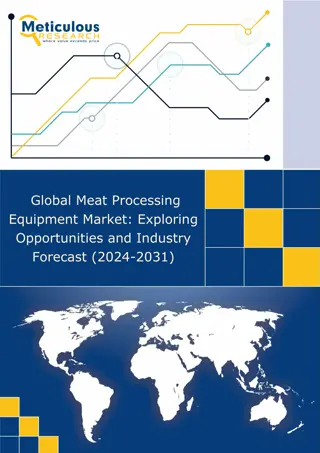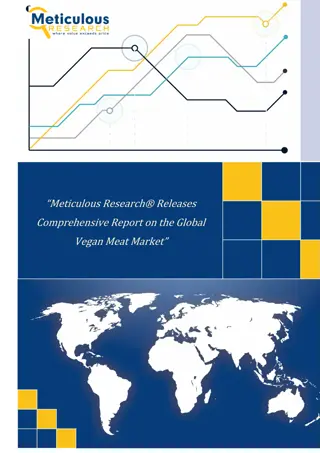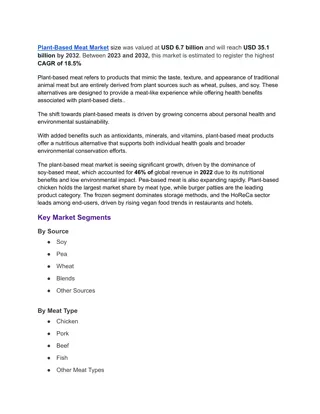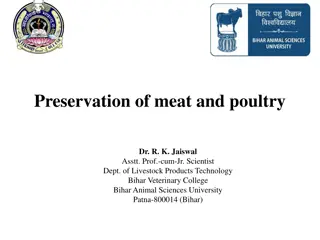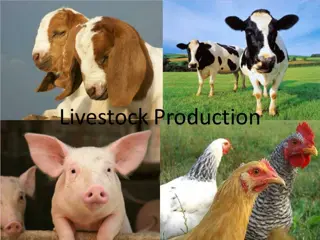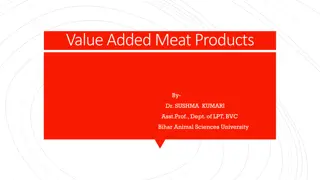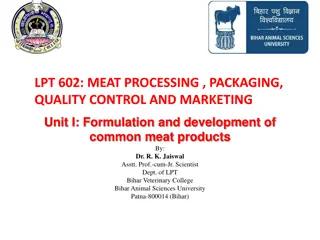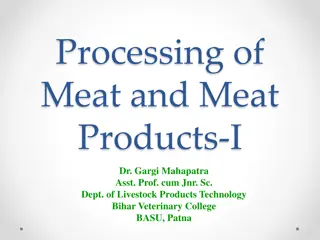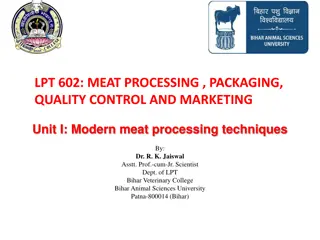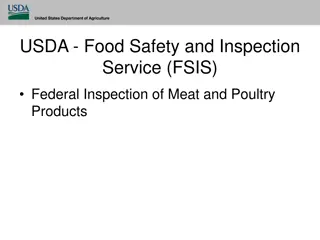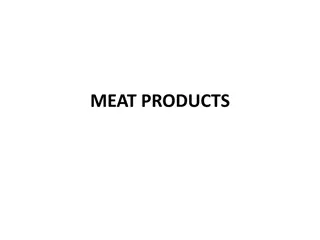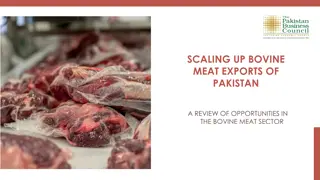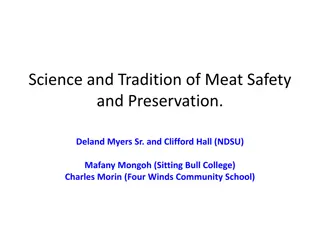
Exploring Animal Tissue Structure and Meat Science
Dive into the fascinating world of animal tissues and meat science with a detailed exploration of muscle types, tissue structure, and the intricate components that contribute to the composition of meat. Learn about the essential role of Meat Technology in handling, processing, and marketing meat products, along with an overview of types of muscular tissue and the importance of skeletal muscles in meat production.
Download Presentation

Please find below an Image/Link to download the presentation.
The content on the website is provided AS IS for your information and personal use only. It may not be sold, licensed, or shared on other websites without obtaining consent from the author. If you encounter any issues during the download, it is possible that the publisher has removed the file from their server.
You are allowed to download the files provided on this website for personal or commercial use, subject to the condition that they are used lawfully. All files are the property of their respective owners.
The content on the website is provided AS IS for your information and personal use only. It may not be sold, licensed, or shared on other websites without obtaining consent from the author.
E N D
Presentation Transcript
LPT 601: FRESH MEAT TECHNOLOGY UNIT I: Structure and chemistry of animal tissues Dr. R. K. Jaiswal Asstt. Prof.-cum-Jr. Scientist Dept. of Livestock Products Technology Bihar Veterinary College Bihar Animal Sciences University Patna-800014 (Bihar)
Meat meat Animal tissues which are suitable for use as food meat More postmortem component originating animals precisely edible from live
Meat terms Meat Science The basic study of the unique characteristics of muscle and other animal tissues that are used as meat, includes all facets of the meat industry, beginning with animal production and ending with final preparation for consumption. Meat Technology Deals with the handling, processing, packaging, preservation and marketing of meat, meat products and byproducts at industrial scale.
Muscle and Associated Tissue Types of Tissues Muscle tissue Nervous tissues Epithelial tissues Connective tissues Adipose Tissues
Types of Muscular Tissue 77_02 Skeletal Muscle Voluntary and striated Smooth Muscle Involuntary and smooth smooth%2520muscle%252040xweb Cardiac Muscle Involuntary and striated 19917 08_016 Muscle-774348
Skeletal Muscles There are more than 600 muscles in animal body Vary widely in shape, size and actions. In general Skeletal muscle constitute 35-65% of meat Muscle Muscle Epimysium Muscle bundle Perimysium Muscle fiber Endomysium & Sarcolemma Myofilaments Myofibril Muscle fiber constitute 75-92% of total muscle volume. Remaining are connective tissues, blood vessels, nerve fibers and ECF
Sarcolemma Skeletal%2520Muscle%2520(230101) Membrane surrounding the Muscle fiber Made up of protein and lipid material 300px-Musclon2 Elastic in nature Invaginations from Sarcolemma forming 019852403x a tubular network Transverse Tubules/ T system/ T Tubules muscle_fiberw Small mound on the surface of muscle fiber (sarcolemma) where motor nerve fiber terminate Motor End Plate
Sarcoplasm Cytoplasm of Muscle cell In addition to 75-80% water contains lipid droplets, glycogen granules, ribosomes, numerous protein, NPN compounds and inorganic constituents Nuclei Multinucleated smooth MUSCLE4 At tendinous attachment more concentrated and irregularly distributed. High in number at motor end plate Peripheral in location in mammals whereas in fish central.
Myofibrils Usually 1-2 m in diam. Parallel to long axis Fibers with diam. of 50 m can accommodate 1000-2000 myofibrils Contractile unit is sarcomere (between two adjacent Z line) Light and dark band I Band (Isotropic/less dense) singly refractive, whereas A Band (Anisotropic/much dense) doubly refractive I band bisection by thin dense line Z line
Myofilaments Thick filaments of vertebrates 14-16 nm in diam. and 1.5 m long (Myosin predominant/A band) Thin filaments of vertebrates 6-8 nm in diam. and 1.0 m long on either side of Z disc (Actin predominant/ I band) Orderly arrangements of Thick and Thin filament Thick and thin overlapping in certain region accounts for striations In cross section of A band region Six thin filaments surround each thick filament Each Actin filaments connect with 4 oblique Z filaments (Z line)
Sarcoplasmic reticulum System of Tubules and cisternae/Intracellular membrane structure acting as Flattered reservoirs of Ca2+ andcorresponds to ER of other cells Thin tubules of SR oriented in direction of myofibril- Longitudinal tubules and in H zone it forms a perforated sheet called as fenestrated collar. At the junction of A and I band the longitudinal tubules join with lagers transversely oriented tubules called terminal cisternae. The T tubules also runs transversely across the sarcomere at A-I junction Connecting elements exist between terminal cisternae and T tubules. SR and T tubules are separate, SR constitute 13% of total muscle fiber volume where as T tubules approx 0.3%.
Mitochondria mitochondria Powerhouse of cell Great variation in mitochondrial size and their number in muscle fibers Abundant at periphery near the poles of nuclei and motor end plates HSP90s Additional at A-I band junction, Z disc and I bands Lysosomes Cathepsins a group of proteolytic enz. golgifigure1 Golgi Complex Near the nuclei Flattened vesicles, function as concentrating and packaging apparatus.
Sarcomere length, Dimension of I band and appearance of H Zone, Pseudo H zone and M line change with contraction state.
Smooth Muscles SMOOTH%2520MUSCLE%2520COMPOSITE Innervated Nervous System Found primarily in the walls of hollow organs & tubes In most of the case spindle-shaped cells typically arranged in sheets Single nucleus centrally located Cells do not have t-tubules & have very little sarcoplasmic reticulum No Z line or M line and striation Actin and Myosin proportion Occurs single or in bundle and surrounded by network of reticular fiber by the Autonomic smooth_muscle_fiber in same
Contd.. 351Blabeled_copy Two types of smooth muscle: 1. Visceral or Unitary smooth muscle Found in the walls of hollow organs (e.g., small blood vessels, digestive tract, urinary system, & reproductive system) Multiple fibers contract as a unit (because impulses travel easily across gap junctions from cell to cell) &, in some cases, are self- excitable (generate spontaneous action potentials & contractions) 2. Multiunit smooth muscle Consists of motor units that are activated stimulation Found in the walls of large blood vessels, in eye (adusting the shape of the lens to permit accommodation & the size of the pupil) tonic by nervous sm1b
Cardiac Muscle Myocardium, the contractile layer of the heart, contains the bulk of the cardiac muscle Single centrally placed nucleus, fibers branched and shorter Sarcoplasm with numerous granules Mitochondria especially numerous, extensive blood circulation. Aggregates of myofilaments form fibrils of extremely variable size T Tubules at Z disc, SR less developed and terminal cisternae absent. Intercaleted disc- transecting the fiber, occurs at regular interval across I bands glycogen MuscleCardiacCells large and 019852403x



